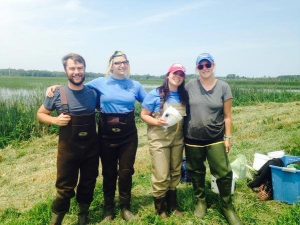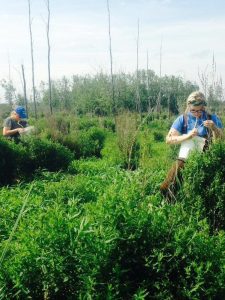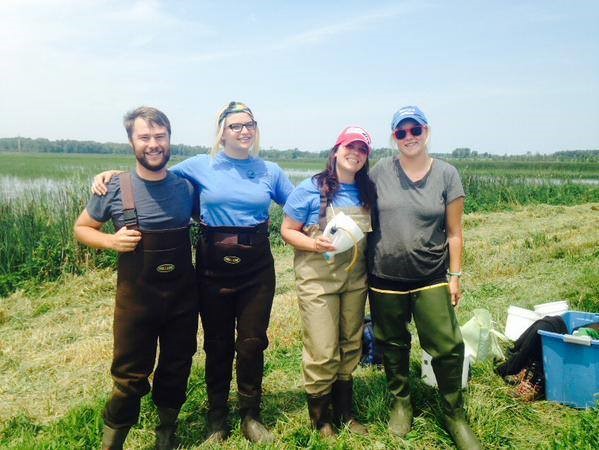
WNY PRISM 2015 Invasive Species Management Crew (left to right: Mat Bilz, Lexy Wagner, Patricia Shulenburg, Lucy Nuessle) getting ready to collect purple loosestrife biocontrol beetles. photo credit: WNY PRISM
On July 7 and 8, 2015, the WNY PRISM Crew visited Iroquois National Wildlife Refuge (NWR) to help with the collection of a biocontrol for purple loosestrife (Lythrum salicaria). Purple loosestrife is an herbaceous, wetland perennial that is found in a wide range of habitats. It is problematic because it is a prolific seed producer and its large canopy suppresses native herbaceous plant cover, leading to a monoculture of purple loosestrife. This invasive plant threatens wetland structure and function by reducing native biodiversity, forage and cover.
Luckily, the use of Galerucella beetles (Galerucella calmariensis and G. pusilla) has proven to be a successful biocontrol for purple loosestrife. Since their initial release, they have become widely established where the invasive plants are present. A single female can lay as many as 400 eggs in a lifetime. These beetles are defoliators and with large enough populations, Galerucella beetles can defoliate 100% of an individual plant. Larvae feed on the underside of leaves, eating the photosynthetic tissue creating a “window-pane” effect, while adults eat straight through the leaves and shoot tips creating a “shothole” effect.

WNY PRISM Crew members Lucy and Lexy collect Galerucella beetles from purple loosestrife plants using aspirators. photo credit: WNY PRISM
The WNY PRISM Crew was called to help our Partners collect these defoliating beetles. Assisting Denise Appleby, Frank Morlock, and Bill Wolanske, employees with the NYS Department of Environmental Conservation (DEC) who work out of Iroquois NWR, we collected Galerucella beetles from a nursery on the nearby Tonawanda Wildlife Management Area. Using an aspirator collection device, a total of twelve thousand beetles were collected over two days!
Wearing waders, the group walked through marshes searching for purple loosestrife plants. By shaking the stems, all insects on the plant would fall into a collection bucket. From here, the desired Galerucella beetles were removed from the bucket using the aspirator devices. These beetles were then shipped to many organizations across the state to help combat the invasive purple loosestrife. With the number of beetles we helped to collect, DEC was able to fill all of their current orders, putting them in a great position to fill any last minute orders that come in!


